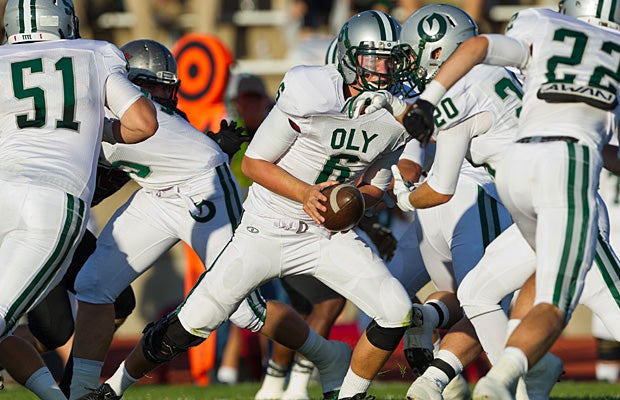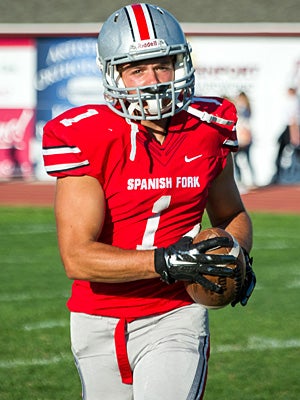
The rivalry between Olympus and Skyline carries more weight now that the teams are in the same region.
Photo by Jeremy Allen
There has never been a shortage of intensity in the annual Battle of the Rock. Since 1962, Salt Lake City foes
Skyline and
Olympus have met in this rivalry grudge match and engaged in many memorable duels.
This neighborhood rivalry between schools separated by only a few miles has taken on greater meaning in recent seasons. After Skyline moved from Class 5A to Class 4A in 2011, the Eagles were suddenly in the same region as the Titans.
Now this rivalry isn't just about bragging rights — it also can determine playoff berths and region titles from one season to the next.
"Playing those teams from the same neighborhood has a different sense of importance when they're in the same classification as you are," Skyline coach Justin Thompson said.
The changes to rivalry games are just one of the side effects Utah high school football teams experience in the realignment process. The Utah High School Activities Association typically adjusts classifications every two to four years to account for changes in enrollment numbers. Some schools can move up or down a classification depending on how much their enrollment has increased or declined since the previous realignment period.
Realignment can have different impacts on the schools involved. In the case of Skyline, it took the Eagles out of Class 5A — where they were among the smallest schools — and put them in 4A where many of the schools more closely matched their athletic profile.

Cash Ripple, Spanish Fork
Photo by Jeff Porcaro
"It helps a lot for the size we have and the number of kids we have," Skyline quarterback
Braxton Chipman said. "But we train to compete with everyone in the state. We train to play against and beat the top tier of teams — whether its 4A or 5A. We train to beat them all."
Realignment helps some schools, but causes challenges for others.
Payson moved to Class 3A from Class 4A after the 2010 season.
The move worked out fine for the Lions at first.
Spanish Fork, a traditional rival, made the same move and both teams were placed into a region featuring reasonable road trips. That all changed in 2013 when Payson was placed in a region where the rest of the schools were either from St. George or Cedar City.
Three- or four-hour one-way trips to play a football game have become a way of life for the Lions the past two seasons.
And it has a negative impact.
JV players end up missing as many as two or three classes during the weeks they travel. And the costs for food and fuel escalate quickly.
"When you're sitting on a bus for eight hours, it's significant," Payson coach Jeremy Chapman said. "It's not easy. And if you do that every single week on top of practice and games, it's physically and mentally draining on the players and coaches."
One school that can sympathize with Payson's plight is
Uintah (Vernal). Geographic isolation coupled with a large enrollment has made lengthy road trips the norm for the Class 3AA school.
Uintah's shortest trip for a region game is
Park City — nearly 2 1/2 hours away from Vernal. The rest of their trips are more than three hours one-way. None of Uintah's natural geographic rivals are even in the same classification. Not surprisingly, the Utes have posted just one winning record since 2001.
"Nobody travels like Uintah travels among the larger schools," Uintah coach Cody Reutzel said. "I definitely think it is a disadvantage to some level. I don't know that it makes our kids more fatigued than anybody else, but it definitely is a grind when we have multiple weeks in a row where we're traveling three, four or five hours."
Geographic isolation for schools like Payson and Uintah came as a direct result of attempts by the UHSAA to even the playing field between larger and smaller 3A schools. Class 3AA — a football-only classification — debuted in 2013 to put 3A schools with larger enrollment numbers in a different classification.
This meant Uintah lost a natural rival like Union from its region. Payson has been forced to use its preseason games to preserve rivalries — leading to taxing schedules that have resulted in an 18-game losing streak for the Lions extending back to the 2013 season opener.
"It is hard," Chapman said. "We try to get those rivalries as best as we can in the preseason, which does make our schedule pretty difficult."
Time will only tell how the next round of realignment will shake things up for other Utah football teams.
John Coon covers Utah high school sports for MaxPreps. You can contact him at john_coon@hotmail.com or follow him on Twitter at @johncoonsports.
